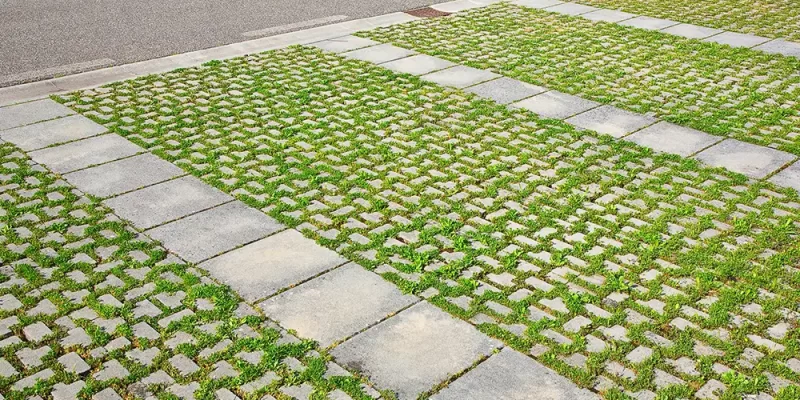While most people aren’t thinking about flooding in the middle of August, that’s exactly what New York City officials were thinking about last month, when they announced that they had started the city’s first major porous pavement installation in Brooklyn.
Flooding is a major concern for many urban areas, especially with the increasing frequency of extreme weather events due to climate change, so New York is following several other major cities by investing in an innovative solution to this problem: porous pavement.
This environmentally friendly paving option offers numerous benefits, including improved stormwater management and reduced flooding risk. And since it combines two of Steadfast’s favorite things (technology and sustainability) we wanted to learn all about what it is, what it’s made of, how it works, and where it has been successfully implemented.
What is Porous Pavement?
Porous pavement, also known as permeable pavement, is a type of pavement designed to allow water to pass through it, reducing runoff and promoting natural groundwater recharge. Unlike traditional impervious surfaces like concrete or asphalt, porous pavement features a network of voids or pores that enable water to seep through the surface and into the underlying soil.
Composition of Porous Pavement
Porous pavement is typically made from a mix of materials designed to create a durable, yet permeable, surface. Common materials used in the construction of porous pavement include:
Porous Asphalt: Similar to traditional asphalt but with reduced fines (small particles), allowing for larger void spaces.
Pervious Concrete: Made with larger aggregate sizes and less sand, creating a network of interconnected voids.
Permeable Interlocking Concrete Pavers (PICP): Concrete blocks designed with gaps between them to allow water infiltration.
Porous Turf: Reinforced grass or turf systems that allow water to percolate through the soil.
How Porous Pavement Works
Porous pavement works by allowing rainwater to infiltrate through its surface, reducing the volume of runoff that typically flows into storm drains and waterways. Here’s a step-by-step look at how it functions:
Infiltration: Rainwater hits the porous pavement surface and begins to infiltrate through the interconnected voids.
Filtration: As the water moves through the pavement layers, it is filtered by the aggregate materials, which can trap pollutants and sediments.
Storage: The water is temporarily stored in the base and sub-base layers of the pavement, which are often designed with high porosity to hold significant volumes of water.
Gradual Release: The stored water slowly infiltrates into the underlying soil or is directed to a stormwater management system, reducing the immediate impact of heavy rainfall and preventing flooding.
Benefits of Porous Pavement
Flood Prevention: By allowing water to infiltrate into the ground, porous pavement reduces surface runoff and mitigates the risk of flooding.
Water Quality Improvement: The filtration process helps remove pollutants from stormwater, improving the quality of water that reaches natural water bodies.
Groundwater Recharge: Using porous pavement promotes the natural replenishment of groundwater, which is crucial for maintaining local water supplies.
Heat Island Effect Reduction: Porous pavement can help lower surface temperatures in urban areas by allowing air and moisture to flow through the pavement.
Sustainable Urban Design: Integrating porous pavement into urban planning supports sustainable development and resilience against climate change.
Examples of Successful Implementation
While July’s introduction of porous pavement to Brooklyn was New York’s first large installation, they join a long list of major cities who have also used it to fix urban flooding:
Chicago, Illinois
The city of Chicago has embraced porous pavement in various projects. For instance, the Green Alley Program retrofitted alleys with permeable materials to reduce stormwater runoff and improve water quality. These green alleys have significantly decreased localized flooding and enhanced the urban environment.
Seattle, Washington
Known for near-constant rain in the winter, Seattle has implemented porous pavement in several of its green infrastructure initiatives. The SEA Streets project, for example, replaced traditional street surfaces with permeable alternatives, resulting in a 98% reduction in stormwater runoff. This project has served as a model for other cities looking to incorporate sustainable stormwater solutions.
Atlanta, Georgia
The city of Atlanta has used porous pavement in various park and recreational area projects. The Historic Fourth Ward Park features permeable pathways and parking areas that help manage stormwater. This approach has not only reduced flooding but also created a more enjoyable and environmentally friendly public space.
Porous pavement is a sustainable and effective solution for managing stormwater and preventing flooding in urban areas. By allowing water to infiltrate through its surface, it reduces runoff, improves water quality, and promotes groundwater recharge.
Cities like Chicago, Seattle, Atlanta, and now New York have successfully implemented porous pavement in various projects, demonstrating its potential to enhance urban resilience and sustainability. As climate change continues to pose challenges, adopting innovative solutions like porous pavement will be crucial in creating more resilient and livable communities.
Are you excited about new technologies that promote sustainability? Then you’ve come to the right place! At Steadfast Entities we’re proud to offer state-of-the art equipment from generators to earth moving equipment that can help you complete your next project quickly and efficiently.

